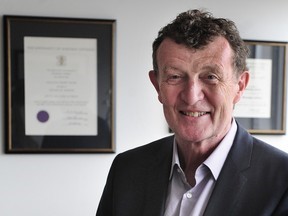Former B.C. Cancer head says it’s sad lack of action means patients are being sent to U.S.
The decision to send some cancer patients to the U.S. for treatment indicates a “significant failure” of the system to deal with the influx of cancer cases that oncologists have been warning the province about for more than a decade, says the former head of B.C. Cancer.
Dr. Malcolm Moore, a medical oncologist who led B.C. Cancer from 2014 to 2019, said he was saddened by news that as many as 4,800 breast cancer and prostate cancer patients over the next two years will be sent to clinics in Bellingham, Washington, because “it fundamentally indicates a fairly serious systemic failure.”
Moore said it’s good that cancer patients waiting for radiation will have access to faster treatment in the U.S. “but you have to look at why did things fail such that such a drastic step has to be made?”
Moore, now a medical oncologist at the Princess Margaret Cancer Centre in Toronto, said he and his predecessor, Dr. Max Coppes, who led B.C. Cancer from 2012 to 2014, were concerned about the projected rise in cancer patients and the absence of a plan from the province to build the facilities and hire the cancer care specialists needed to meet the demand.
Frustrated at the lack of action, Coppes left just two years into his five-year term. In 2015, he published an article in the B.C. Medical Journal projecting that B.C.’s aging and growing population would lead to an almost 60-per-cent increase in cancer cases in the next 15 years.
Moore echoed those concerns during his time with the cancer agency.
“I became very concerned, very early on, that there was really no plan to add any additional radiation facilities, any additional cancer centres,” Moore said. “And that was what kept me up at night.”
In an interview with Postmedia News on Thursday, the cancer agency’s current chief medical officer, Dr. Kim Nguyen Chi, acknowledged B.C. “needed a cancer strategy 20 years ago.”
However, he’s confident the NDP government’s $440-million plan to expand cancer care over the next decade will dramatically reduce waiting times at each stage of patients’ medical journeys.
In the short-term, Chi said the plan to send about 20 per cent of those needing radiation therapy to either the PeaceHealth St. Joseph Cancer Center or the North Cascade Cancer Center starting May 29 will immediately address the backlog here in B.C.
“I’ve seen a lot of political commentary … but I’m going to stay away from politics,” said Chi, a medical oncologist and an internationally recognized expert in prostate cancer who has been with B.C. Cancer since 1997. “I think at the heart of it, we needed to do something for our patients. We really needed to increase capacity, so patients could get treated sooner.”
It will cost the province three times as much to treat patients in the U.S.: $12,277 for a patient receiving five fractions of radiation therapy compared to $3,854 here in B.C., according to the Health Ministry. Those figures do not include travel and accommodation costs, which the province will pay for.
The province has budgeted $39 million a year for the two-year program. Health Minister Adrian Dix acknowledged this week it’s a more expensive option, but it was the best one for patients.
Chi said his team did inquire about treatment options in Alberta or other provinces, but “they’re also facing constraints.”
“It’d be great to stay within Canada, but at the same time going to Bellingham is also much closer for people in B.C., particularly in the Fraser Valley.”
As for who will be selected to travel to Washington state, Chi said breast cancer and prostate patients will be triaged based on how long they’ve been waiting for treatment and the number of radiation sessions needed.
“We’re going to be targeting folks that would only have five consecutive days of treatment,” Chi said. That limits the length of time people are away from home.
Breast cancer and prostate cancer patients were selected first since they make up the largest patient population receiving radiation and face the longest waiting times. More cancer patients could be selected for the program if there’s capacity, Chi said.
Chi hopes that by sending 50 patients a week, or 20 per cent of patients needing radiation, to the U.S., waiting times here will improve in the coming weeks or months. In the longer term, Chi said he’s confident the 10-year cancer plan will recruit the necessary cancer care staff, including badly needed oncologists and radiation technologists, and fund the expansion of cancer care centres in Nanaimo, Surrey, Burnaby and Kamloops.
B.C. Cancer currently has 50 vacancies for radiation technologists, the medical professionals who work with oncologists to plan and deliver radiation therapy treatments.
Irving Gold, CEO of the Canadian Association of Medical Radiation Technologists, said in a statement Thursday that radiation therapists and the association have spent the last year trying to raise the alarm with the health minister “about high levels of burnout among medical imaging and radiation therapy professionals and how this might affect patient care.”
Leaked B.C. Cancer figures released by B.C. United on Wednesday show the percentage of cancer patients who start radiation treatment within the Canadian benchmark of 28 days is just 77 per cent in B.C., much lower than the 82.9 per cent quoted by Health Minister Adrian Dix on Monday. That’s well below the national average of 97 per cent and one of the worst rates in the country.





